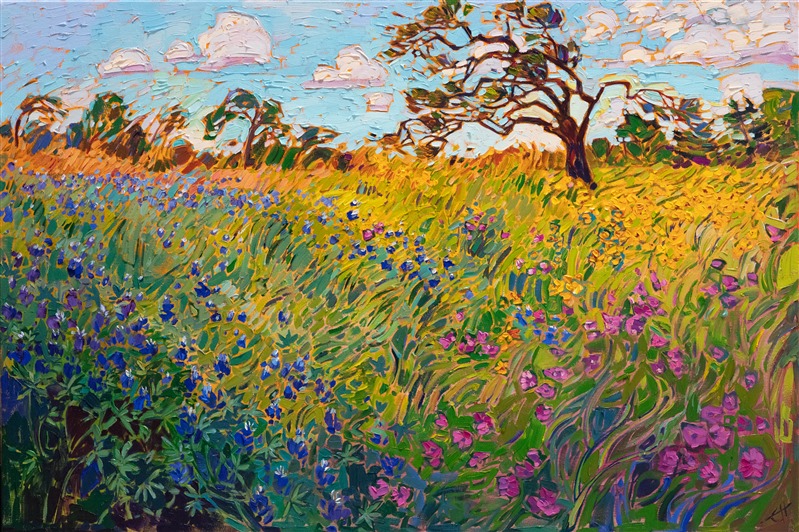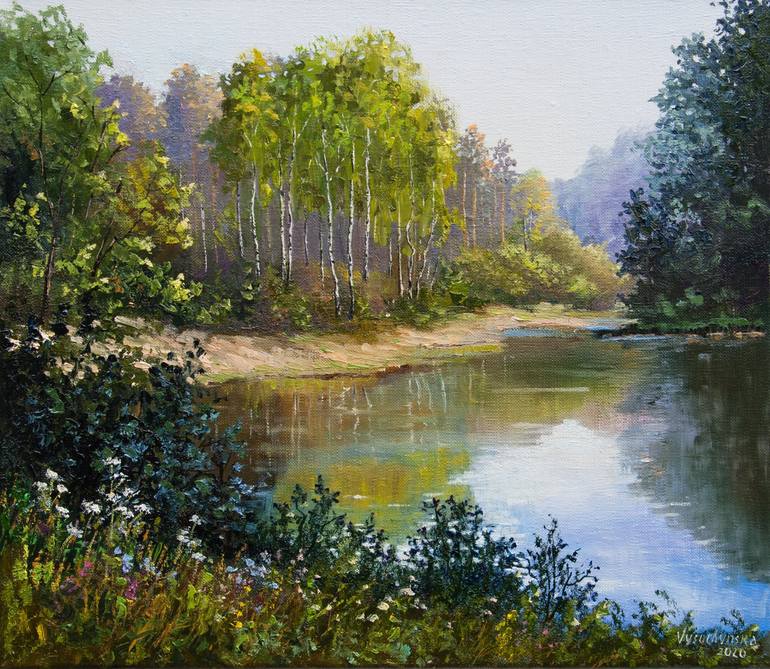Abstract and Contemporary Oil Paintings for Sale
Abstract and Contemporary Oil Paintings for Sale
Blog Article
Exploring All About Oil Paints: A Guide to Understanding Their Beauty and Value
Oil paintings have captivated target markets for centuries, using a glance into the artistic proficiency of numerous ages. Their rich background is intertwined with cutting-edge methods and extensive emotional expression. Comprehending the products and approaches behind these artworks can enhance appreciation. Additionally, the marketplace for oil paintings presents opportunities for collection agencies and capitalists alike. As one discovers this fascinating world, the inquiry develops: what makes an oil paint genuinely useful?
The Background of Oil Paint: A Trip Via Time
Oil painting has origins that date back to old times, it really grew during the Renaissance, when artists discovered its convenience and abundant color potential. Early instances can be mapped to the 7th century, with methods progressing notably throughout societies. The medium ended up being famous in Northern Europe in the 15th century, specifically with the jobs of artists like Jan van Eyck, who pioneered its use for in-depth realism and vivid tones. This period noted a separation from tempera paints, permitting higher depth and appearance. As oil paint spread, it affected numerous artists, causing masterpieces by renowned figures such as Leonardo da Vinci and Rembrandt. The tool's tradition proceeds, shaping the art world well right into modern-day times.
Recognizing Oil Repaints: Materials and Techniques
As artists check out the globe of oil paints, they encounter a varied selection of materials and techniques that specify this tool. The main components of oil paint include pigments, which supply color, and drying out oils, such as linseed, that bind the pigments and promote application. Various additives can customize the paint's structure and drying out time, improving versatility. Methods like glazing, where transparent layers are accumulated, and impasto, which entails applying thick paint, allow for various visual effects. Additionally, making use of brushes, combination blades, and even fingers can produce one-of-a-kind appearances and coatings. Understanding these strategies and materials makes it possible for artists to fully reveal their creativity and attain the desired effect in their art work.
The Duty of Color in Oil Paints
Color plays a pivotal duty in oil paints, influencing both aesthetic charm and emotional resonance. Understanding color theory essentials, including the partnerships in between colors, can boost an artist's ability to share state of mind and environment. Additionally, understanding shade mixing techniques permits for better depth and richness in a paint's scheme.

Shade Concept Fundamentals
Recognizing shade theory is vital for artists working with oil paints, as it forms the foundation for developing aesthetically appealing and harmonious compositions. Shade concept includes the research study of exactly how colors engage, the shade wheel, and the connections between key, second, and tertiary shades. Artists use complementary shades to improve contrasts and develop centerpieces, while analogous colors advertise unity and cohesiveness within a piece. Furthermore, the ideas of warm and awesome shades influence the perception of depth and room in a paint. Realizing these concepts permits musicians to control shade effectively, assisting the customer's eye and communicating their intended message. Proficiency of shade theory eventually enriches a musician's ability to share feelings and ideas with their job.
Psychological Influence of Color
The emotional impact of color in oil paintings plays a critical role in how customers perceive and attach with artwork. Colors stimulate particular feelings and state of minds, affecting the audience's mood. For example, warm colors like oranges and reds can develop a feeling of warmth and power, while great tones such as blues and eco-friendlies commonly evoke calmness or introspection. Artists purposefully pick shade combinations to boost narrative elements, directing the audience's psychological trip. The saturation and contrast of colors better amplify these results, drawing attention and producing emphasis. Inevitably, the interaction of shades in oil paints not only boosts their visual allure but also acts as a powerful medium for emotional expression, enhancing the viewer's experience and analysis.
Color Mixing Techniques
While lots of aspects of oil paint add to the total make-up, grasping color mixing methods is important for attaining wanted results and depth. Color mixing can be come close to with various approaches, including the subtractive and additive procedures. Additive mixing includes combining shades of light, while subtractive mixing counts on pigments, where shades blend to create new shades. Artists usually use a limited scheme to develop harmonious jobs, understanding the relationships between key, second, and tertiary colors. Techniques such as glazing and scumbling better improve deepness and luminosity. By masterfully blending shades, a musician can evoke feelings, produce focal factors, and accomplish a sense of realistic look, ultimately raising the painting's aesthetic and psychological impact.
Famous Oil Painters and Their Iconic Works

Renowned for their mastery of shade and strategy, oil painters have actually developed some of one of the most popular art work in history. Distinguished musicians like Vincent van Gogh mesmerized audiences with his emotive brushwork in "Starry Evening," while Claude Monet's "Perception, Dawn" laid the groundwork for Impressionism. Leonardo da Vinci's "Mona Lisa" remains a long-lasting sign of artistic brilliant, showcasing his ability in recording human expression. On the other hand, Rembrandt's "The Night Watch" shows his ingenious use light and shadow. Various other remarkable numbers consist of Pablo Picasso, that transformed modern art with his strong trial and error in jobs like "Les Demoiselles d'Avignon," and Georgia O'Keeffe, whose vivid depictions of landscapes and blossoms helped specify American innovation. Each artist's special style contributed significantly to the oil painting landscape.
Just how to Evaluate the High Quality of an Oil Paint
Assessing the high quality of an oil paint involves a careful assessment of craftsmanship techniques, in addition to an analysis of shade and composition. Observing brushwork, layering, and the application of paint can expose the musician's skill degree. Furthermore, the interplay of colors and the total setup of components contribute substantially to the painting's visual worth.
Evaluating Craftsmanship Methods
A meticulous evaluation of craftsmanship techniques is essential for establishing the high quality of an oil painting. Evaluators must initially take a look at the application of paint; thick, textured brushstrokes might suggest a knowledgeable hand, while excessively uniform applications might indicate an absence of deepness. oil paintings for sale. The layering method is also important; the presence of glazes and differed density can improve luminance and complexity. Furthermore, the top quality of the products made use of, such as the canvas and pigments, plays a significant duty in toughness and total aesthetic. Focus to detail in elements like edges and shifts between colors mirrors the musician's dedication to their craft. Eventually, these strategies add to the painting's psychological effect and market price, working as indications of the musician's skill and intent
Evaluating Color and Composition
While evaluating the top quality of an oil painting, one must concentrate on the interaction of shade and make-up, as these elements are fundamental to the artwork's general effect. Shade choices can stimulate feelings and develop mood; consequently, the musician's scheme should be analyzed for harmony and contrast. A well-balanced composition directs the customer's eye and creates a sense of unity. Artists typically utilize methods like the guideline of thirds or leading lines to enhance visual interest. In addition, making use of light and darkness can include deepness, enhancing the three-dimensionality of the paint. Inevitably, an effective oil painting marries shade and make-up, engaging the audience and inviting a much deeper admiration of the musician's vision and strategy.
Taking care of and Preserving Oil Paintings
Proper care and preservation of oil paintings is necessary for keeping their honesty and long life. To protect these artworks, it is vital to display them away from direct sunlight, which can cause fading and discoloration. Maintaining a stable environment with controlled temperature level and moisture more help in preventing damage. Cleaning should be done gently using a soft, dry cloth, avoiding any harsh chemicals that could damage the paint or varnish. Normal examinations for indications of degeneration, such as flaking or breaking, are suggested. When keeping or carrying oil paintings, proper extra padding and framing are necessary to stay clear of physical damage. Ultimately, diligent treatment contributes to the aesthetic appeal and worth of oil paints in time.
The Marketplace for Oil Paintings: Investing and gathering
Recognizing the market dynamics for oil paintings is crucial for investors and enthusiasts alike. The value of these art work is influenced by numerous variables, consisting of the musician's credibility, historic value, and present patterns. Enthusiasts frequently seek pieces that reverberate personally while considering prospective recognition in worth. Galleries and auctions act as primary locations for trading, with costs changing based on demand and rarity. Spending in oil paintings needs study into the market, along with an understanding of authenticity and provenance. Furthermore, arising musicians may use opportunities for considerable returns, while developed names can regulate high prices. Generally, a strategic strategy to collecting can produce both visual satisfaction and monetary incentives.

Frequently Asked Inquiries
What Are the Environmental Influences of Oil Painting Products?
The environmental influences of oil painting products include the launch of volatile organic substances (VOCs), dangerous waste generation, and resource extraction for pigments. These variables contribute to contamination and environmental deterioration, elevating problems amongst eco aware musicians and customers.
Just How Do Various Canvases Influence Oil Paint Outcomes?
Different canvases affect oil painting results substantially. Surface area, absorbency, and appearance high quality can change paint application, drying out times, and shade vibrancy. Artists usually choose particular canvases to attain wanted effects and enhance their creative expression.
Can Oil Paintings Be Brought Back if Harmed?
Oil paintings can certainly be brought back if harmed. Professional conservators use numerous strategies to fix rips, tidy surfaces, and address discoloration, guaranteeing that the art work maintains its initial elegance and worth for future generations.
What Are the Indicators of an Initial Oil Paint?
The indicators of an initial oil painting consist of noticeable brush strokes, appearance variants, and an irregular canvas weave (oil paintings for sale). In addition, credibility might be validated via provenance, trademarks, and the visibility of a varnish layer one-of-a-kind to oil tools
Just How Has Modern Technology Influenced Modern Oil Paint Techniques?
Innovation has considerably affected contemporary here oil painting techniques by introducing electronic devices for preparation, enhanced products for appearance and long life, and on the internet platforms for sharing and selling art, therefore increasing musicians' creative opportunities and audience get to. Oil paint has roots that date back to ancient times, it really flourished throughout the Renaissance, when musicians discovered its flexibility and abundant shade capacity. The emotional influence of color in oil paints plays a crucial duty in exactly how audiences view and attach with art work. While numerous aspects of oil paint contribute to the overall make-up, grasping shade mixing methods is necessary for attaining desired results and depth. Assessing the top quality of an oil paint entails a mindful assessment of craftsmanship techniques, as well as an analysis of color and structure. While examining the top quality of an oil paint, one have to concentrate on the interaction of shade and make-up, as these elements are fundamental to the artwork's overall impact.
Report this page